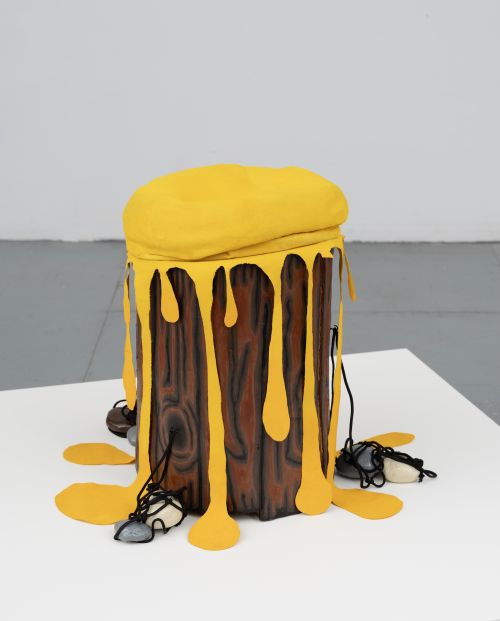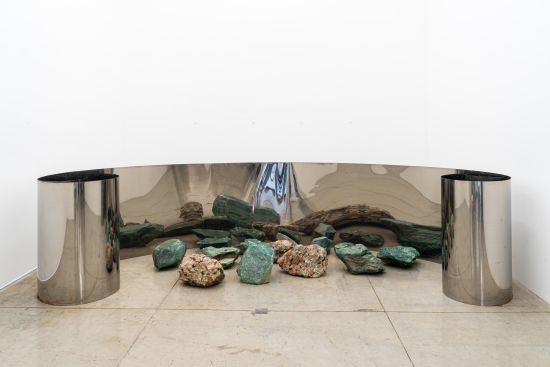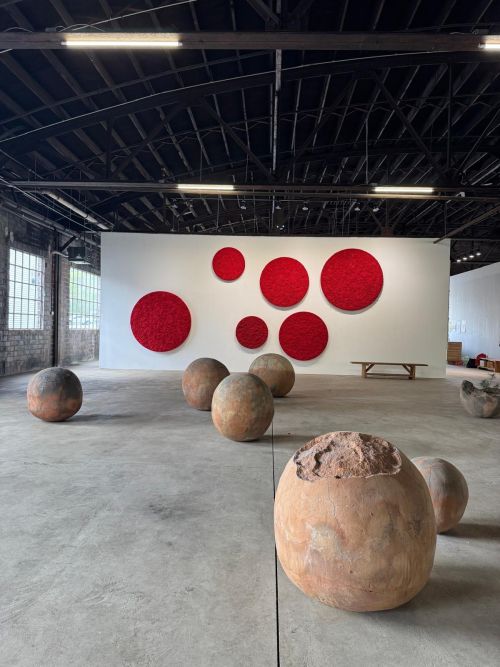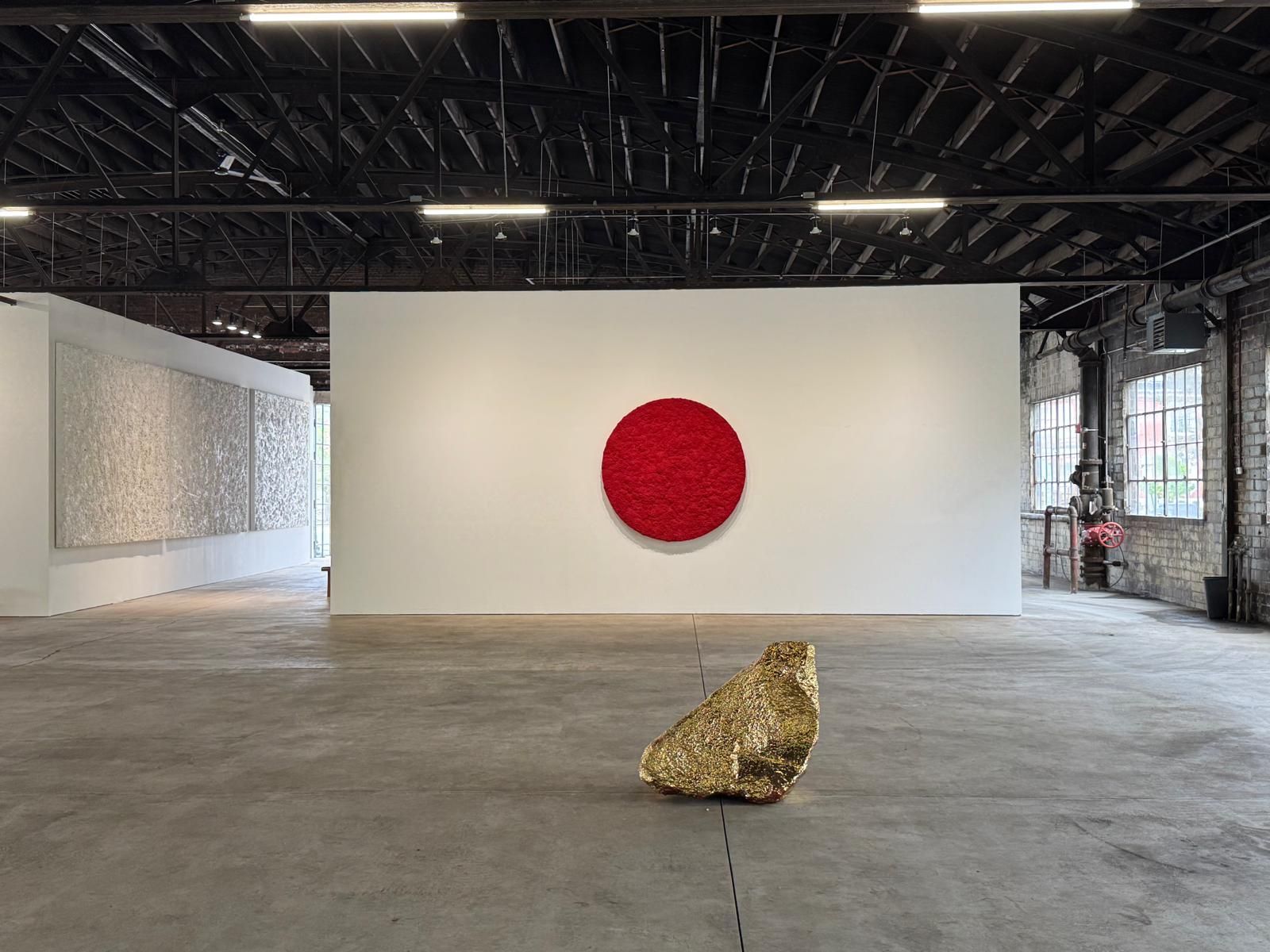ASSEMBLY 4
In year four, this space—its scale, ruggedness, and sheer improbability, combining with dramatic light and founder Bosco Sodi’s determination to see it well used artistically and socially, continue to be the driving forces behind the exhibition program.
Jason Fox
The Hudson Valley is not only rich in artists, it is home to a huge number of super-accomplished artist couples. Last year, Huma Bhaba (who made a glorious exhibition for Sodi’s Casa Wabi in Oaxaca in 2022), and her partner Jason Fox made a neighborly visit at Bosco’s invitation. Walking around, viewing the front gallery installations of paintings by Davide Balliano and Johnny Abrahams, Bosco asked Jason if he had work languishing in storage and whether he might be interested in showing it here. And sure enough he did and was.
It is always enlightening to see what kinds of work artists have kept. In this instance our choices were somewhat circumscribed by the fact that the space has become rawer over time, as we have abandoned early attempts to condition the environment to museum, or even household, standards. Assembly is no Sơn Đoòng Cave (Vietnam), which, with an estimated volume of 38.5 million cubic meters has spaces large enough to hold a 40-story skyscraper, and sports a jungle, a river, and its own clouds. But this former 1950s Buick dealership, built to the specifications of interstate manifest destiny, is still pretty big to heat and cool. After some back and forth, we settled on this group of three paintings and three sculptures, which pretty effectively show Jason’s approach to art making.
Jason is a public intellectual, in the now somewhat old fashioned sense of exhibiting a sense of moral responsibility to be well-informed about his people, and their for-better-or-worse passions, and to process and synthesize what he observes in noble, (frustrated, futile, faltering), Quixotean efforts to cultural critic the nation into more reflection and self-awareness. Among these angels and devils, heroes and villains, all such designations are, of course, subject to the eye, and intellectual leanings, of the beholder. The high-octane mix of ripped-from-the-headlines alarmism and cartoonish idealization is above all else quintessentially American. With the messianic but ingenuous intensity of a John Brown or a Tom Cruise, they recall the first line of William Carlos Williams’ “To Elsie,” in which he offers this crisp diagnosis, “The pure products of America go crazy…”
In the Brazilian Way
The explosion of interest in Latin American art, as broad and enriching as it has been, has barely scratched the depth and quality of Brazilian art. For anyone interested in work that feels specifically and meaningfully connected to life and engaged with universal aesthetics—that is frequently, simultaneously all, or most of, conceptual, empirical, beautiful, social, political, and emotionally punchy, Brazil is Shangri-la. Where art from the United States has moved towards self-balkanizing, narrowly drawn, and even more narrowly appreciated, niches—Brazilian artists consistently find compelling ways to blend and extend. This is particularly notable in the fraught realm of hybrid identity formation, which Brazilian artists tend to tackle with a combination of frankness and idealism that puts the facade collapse of the American dream to shame.
This is also true of artists working in what might broadly be termed as the Brazilian way—such as the Portuguese artist Carlos Bunga, whose use of humble, ephemeral materials and sensitivity to architectural space and transformation resonates strongly with core tenets of Brazilian conceptual and constructive traditions. His consciously transatlantic practice is a powerful model of old world/new world reconciliation. It is also emblematic of the artists (and estates) represented by Nara Roesler gallery of Sao Paulo, Brazil, whose New York space has done so much to champion and disseminate these values. This selection of work by five of Nara Roesler’s artists highlights one of the great strengths of Brazilian art: meaning made directly from the choice and use of materials.
Studio Bosco Sodi
For the latest installation of work from his New York studio, Bosco decided to make himself a set of round red paintings in various sizes. Examples of these crimson terraforming petri dish paintings have dispersed all over, from Venice to Seoul. But this group is intended for his permanent, home base studio-museum in Mexico City. First, however, they’ll make a stop here: a chance to test the viral fever dream on an architectural scale.
We all know the American psyche has experienced core meltdown. The contamination is inescapable. We’re all burned; we’re all radioactive. This national catastrophe dovetails perfectly with the now continuous state of incipient natural disaster that is the new global normal, from wildfire and financial calamity to actual pandemia. The hostile state of unbelonging in which we now find ourselves is the root of the unifying anxiety we can’t shake. In this climate it’s hard not to read Bosco’s red circles as holes: wounds in the body politic. We’re so shot to hell with irreconcilable differences, it’s hard to see anything else.
But the whole point of Assembly is to say it’s OK to let some of that go: to seek some refuge by stepping away. These material paintings, which have traveled widely, and been so widely appreciated as representatives of a shared experience of earth, are not holes in the fabric of reality but patches—and if holes, then gateways to, and footholds in, a more serene and solid land.
– Dakin Hart
JASON FOX
Focus Gallery Right

For almost thirty years, Jason Fox (b. 1964, Yonkers, New York) has painted pictures that inhabit the charged psychological spaces within American culture, as well as within the medium of painting itself. Exhibiting frequently at Feature Inc., among other galleries in the 1990s, he moved against the grain of prevailing appropriation-based and conceptual methodologies. His idiosyncratic, risk-taking paintings then and since have been filled with imaginary beings informed by modernist art, autobiographical reflection, and mythological symbolism, and a recurring cast of characters from comics, fantasy cinema, and popular music. As such, Fox produces pictures that condense broad propensities in the collective imagination into intimate images whose every brushstroke and color choice carries emotional weight. These unlikely but arresting pictures—suffused with Dadaist humor—make the most of painting’s ability to register organic, intuitively rendered changes in form and perspective. In many works from the last few years, Fox fuses portraits of well-known figures as well as images of his dog, demons, and angels. These hybridized beings appear to morph before the viewer’s eyes, communicating a sense of the fluidity with which they take shape on the canvas. This makes his work as personal and introspective as it is accessible, immediately recognizable, and culturally resonant.
IN THE BRAZILIAN WAY
Focus Gallery Left

Founded in 1989, Nara Roesler has established itself as one of Brazil’s leading contemporary art galleries. It is recognized for playing a fundamental role in promoting, consolidating, and internationalizing its artists. Based in São Paulo, it expanded its program to Rio de Janeiro in 2014 and became the first Brazilian gallery to establish an international presence by opening a space in New York in 2015, reinforcing its commitment to spreading Brazilian art on the global stage.
Carlos Bunga (b. 1976 Porto) creates process-oriented works in various formats: sculptures, paintings, drawings, performances, video, and above all in situ installations, that refer to and intervene in their immediate architectural surroundings. While often using ordinary, unassuming materials such as packing cardboard and adhesive tape, Bunga’s work involves a highly developed degree of aesthetic care and delicacy, as well as a conceptual complexity derived from the inter-relationship between doing and undoing, between unmaking and remaking, between the micro and the macro, between investigation and conclusion. Straddling the divide between sculpture and painting, Bunga’s deceptively delicate works are characterized by an intense study of the combination of color and materiality, while at the same time emphasize the performative aspect of the creative act.
Working across various media such as installation, sculpture, photography, video, drawing and performance, Raul Mourão (b. 1967, Rio de Janeiro, Brazil) is part of a generation that marked Rio’s artistic scene in the 1990s. Commenting on subjects as everyday life, politics or social constructs, frequently permeated by a critical sense of humour, one of the main concerns in Mourão’s work is the urban space. His visual vocabulary proposes displacements and redefinitions of familiar symbols and forms in contemporary society as a means of stimulating thought on the matters of place, urbanism and human interactions.
Marcelo Silveira (b. 1962, Gravatá, Brazil) makes work that questions and challenges long-established categories related to art, such as sculpture, folk art, craftwork and collecting. His works often depart from the idea of materiality and how anything can become a medium, spearheading his use of wood, leather, paper, metal, plastic and glass amongst many other materials. Silveira’s investigation also address the idea of the use and purpose of materials or objects, which he suggests can be defined by a common, socially determined repertoire –as is the case for bottles or glasses– and uprooted by recreating familiar shapes using unexpected materials.
Amelia Toledo (b. 1926, São Paulo, Brazil – d. 2017, Cotia, Brazil) started studying visual arts at the end of the 1930s, as she began to frequent Anita Malfatti’s studio. During the following decade, she continued her studies with Yoshiya Takaoka and Waldemar da Costa. In 1948, she started working as a project designer for the architecture studio Vilanova Artigas. Her encounters with iconic figures of Brazilian Modern Art encouraged her to develop a multifaceted oeuvre, entwining diverse artistic languages such as sculpture, painting and printmaking, which further flourished through her contact with other artists of her generation including Mira Schendel, Tomie Ohtake, Hélio Oiticica and Lygia Pape.
At the beginning of the 1970s, Angelo Venosa (b. 1954, São Paulo, Brazil – d. 2022, Rio de Janeiro, Brazil) started attending Escola Brasil, an experimental space for the study of art. In 1974, he moved to Rio de Janeiro, where he enrolled at Escola Superior de Desenho Industrial (ESDI). In the 1980s, Venosa attended open courses at the Escola de Artes Visuais do Parque Lage, where the so-called ‘Geração 80’ began and developed in. While his generation was known for a return to painting, the artist dedicated his practice to sculpture. His work often evokes organic structures, which he builds using wood covered with textiles, resin, glass fiber or bones, beeswax and teeth.
STUDIO BOSCO SODI
Main Gallery

Bosco Sodi (Mexico, 1970) is known for his richly textured, vividly colored large-scale paintings. Sodi has discovered an emotive power within the essential crudeness of the materials that he uses to execute his paintings. Focusing on material exploration, the creative gesture, and the spiritual connection between the artist and his work, Sodi seeks to transcend conceptual barriers. Sodi leaves many of his paintings untitled, with the intention of removing any predisposition or connection beyond the work’s immediate existence. The work itself becomes a memory and a relic symbolic of the artist’s conversation with the raw material that brought the painting into creation. Sodi’s influences range from l’art informel, looking to artists such as Antoni Tàpies and Jean Dubuffet, to master colorists such as Willem de Kooning, Mark Rothko, and the bright hues of his native heritage.
List of Works
